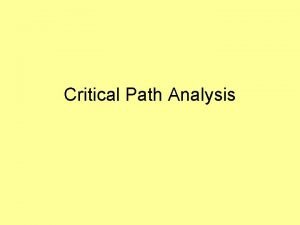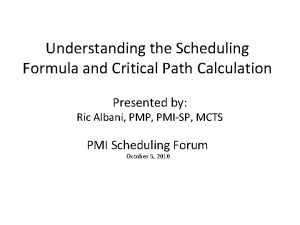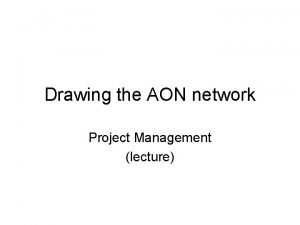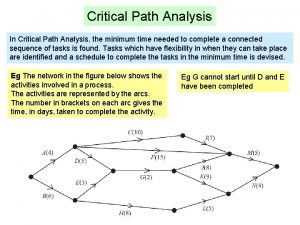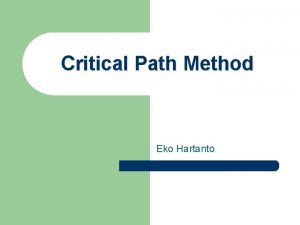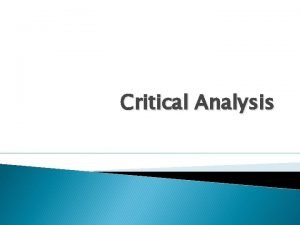FALSE PATH ANALYSIS AND CRITICAL PATH ANALYSIS Presented


![• Some of the examples are 1. set_false__path -from [get_clocks SCAN_CLK] to • Some of the examples are 1. set_false__path -from [get_clocks SCAN_CLK] to](https://slidetodoc.com/presentation_image_h2/53abd0d064913e9dd098c3d18c809241/image-3.jpg)








- Slides: 11

FALSE PATH ANALYSIS AND CRITICAL PATH ANALYSIS Presented by, Deexith V

False path analysis • Certain timing paths are not real in the actual functional operation of the design. Such paths can be turned off during STA by setting these as false paths • Examples of false paths could be Ø From one clock domain to another clock domain, Ø from a clock pin of a flip-flop to the input of another flip-flop, through a pin of a cell, through pins of multiple cells, or a combination of these • A false path is set using the set_false_path specification
![Some of the examples are 1 setfalsepath from getclocks SCANCLK to • Some of the examples are 1. set_false__path -from [get_clocks SCAN_CLK] to](https://slidetodoc.com/presentation_image_h2/53abd0d064913e9dd098c3d18c809241/image-3.jpg)
• Some of the examples are 1. set_false__path -from [get_clocks SCAN_CLK] to [get_clocks CORE_CLK] It means any path starting from the SCAN_CLK domain to the CORE_CLK domain is a false path. 2. set_false_path -to [get_ports TEST_REG*] It means all paths that end in port named TEST_REG* are false paths 3. set_false_path -through UINV/Z -through UAND 0/Z It means any path that goes through both of these pins in this order is false.

• To set a false path between two clock domains, use set_false_path -from [get_clocks clock. A] -to [get_clocks clock. B] Instead of, set_false_path -from [get_pins {reg. A_*}/CP] -to [get_pins {reg. B_*}/D] • Because the second form is much slower • Another recommendation is to minimize the usage of –through options, as it adds unnecessary runtime complexity • The through option should only be used where it is absolutely necessary and there is no alternate way to specify the false path.

Advantages • the analysis space is reduced • focus only on the real paths • Helps to cut down the analysis time as well

Disadvantages • Not to use a false path when a multi cycle path is the real intent • If a false path is used on a path that is sampled many clock cycles later, optimization of the remaining logic may invariably slow this path even beyond what may be necessary

Critical path analysis • STA is used to verify the timing of the design and can also be run prior to performing logic optimization - the goal is to identify the worst or critical timing paths • STA can be rerun after logic optimization to see whethere are failing paths still remaining that need to be optimized, or to identify the critical paths • During physical design, STA can be performed at each and every step to identify the worst paths/critical paths • At the logical design phase, ideal interconnect may be assumed since there is no physical information related to the placement; there may be more interest in viewing the logic that contributes to the worst paths

• Figure may seem to imply that STA is done outside of the implementation steps, that is, STA is done after each of the synthesis, logic optimization, and physical design steps. In reality, each of these steps perform integrated (and incremental) STA within their functionality. • For example, the timing analysis engine within the logic optimization step is used to identify critical paths that the optimizer needs to work on

Advantages • Better allocation of resources • Reduces the risk of task and cost

Disadvantages • Too many activities make the network diagram too complicated

THANK YOU




